#Vulcan tourism
Text
Vulcan, Alberta, Canada
#vulcan#Alberta#Canada#vulcanalberta#Star Trek#sci-fi#science fiction#science#scifi tourism#science tourism#entertainment#live long and prosper#mr spock#space ship#travelfacts#travel#tourism#world facts#canadian tourism#alberta tourism#Vulcan tourism
9 notes
·
View notes
Text
Species-Neutral, Sex-Positive Franchise Opens Stores on Vulcan

"Barely Risa"
Intimate apparel and other gifts direct from the renowned pleasure planet await you hear. The popular chain has been expanding its footprint beyond Risa in recent years, establishing locations on many tourism-heavy worlds and increasing its inventory to serve a host of different species. It's definitely one of the few places on Vulcan where you're liable to find a horga'hn, and seldom will you find Andoridan aphrodisiacs and Orion lingerie in the same store as you can here.
From: Hidden Universe: Star Trek: A Travel Guide to Vulcan
#lmao WHAT#the implications of this are wild#is this from lower decks???#this is so funny to me#star trek#vulcans#raal#vulcan
12 notes
·
View notes
Text
Been thinking about an AOS Star Trek/F1 AU so here's a BIG dump under the cut about it
Formula 1 is considered a vintage sport, having ended with WWIII on Earth and never really coming back due to the advancements in technology and culture making it more or less obsolete. However, due to a rise in interest in the sport many years later, it's then brought back on Earth for nostalgia purposes, intending to only be back for one season. Seeing the popularity of it, the newly recreated FIA decides to bring the sport back permanently, and after a few years, other Federation allies decide to allow F1 races to take place on their planets after seeing the surge in tourism that the sport brought.
The teams assume their "vintage" names from before the war, despite nearly all of the companies no longer existing in a post-capitalist world. In addition to this, there are no sponsors, and the focus of the sport is entirely on the joy of racing and technology.
Earth has retained a large portion of their vintage tracks, but new tracks are added off-planet. Vulcan and Yorktown are of particular interest, with Vulcan being the first fully-vertical circuit, and the hottest, requiring an enclosed cooling tunnel over their track to protect the all-human driver lineup. Yorktown is the newest track, and becomes the first anti-gravity track, with drivers following the roads of Yorktown that often go upside-down.
The overall shape and build of the car remains similar to how they were in the 2020s before the war due to nostalgia purposes, but with some key changes. Rather than a halo, the car is outfitted with a smaller, more compact shield similar to the ones that protect Federation ships. The technology is rather new, and as a result sometimes scrambles other frequencies.
Due to the newer tracks and difference in gravity, cars must also be outfitted with specialized technology to allow them to withstand anti-gravity drives. Tyres are also specialized for this reason.
The cars are much faster, regularly hitting 300mph/480kph, though the G-forces aren't as much of an issue anymore due to upgraded shielding allowing for more impact to be absorbed.
Cars can now light up like Tron bc I want them to
Should a crash or other incident happen, drivers have special "bail buttons" on their steering wheel and the side of their helmets. It's another new technology that allows them to beam from their location straight to their garage. Should the bail button fail, a driver's suit will activate a small, one-time use shield around their body, absorbing any initial impact. Unfortunately, any impact that happens afterwards is on the driver.
For the drivers themselves, their helmets are built into the collar of their suits, and can materialize and de-materialize with the press of a button. In addition, their suits are built from the most updated fabrics, being completely fireproof. They're also more lightweight and hug closer to the body since there is no longer a need for multiple layers of nomex to keep the drivers safe.
5 notes
·
View notes
Text
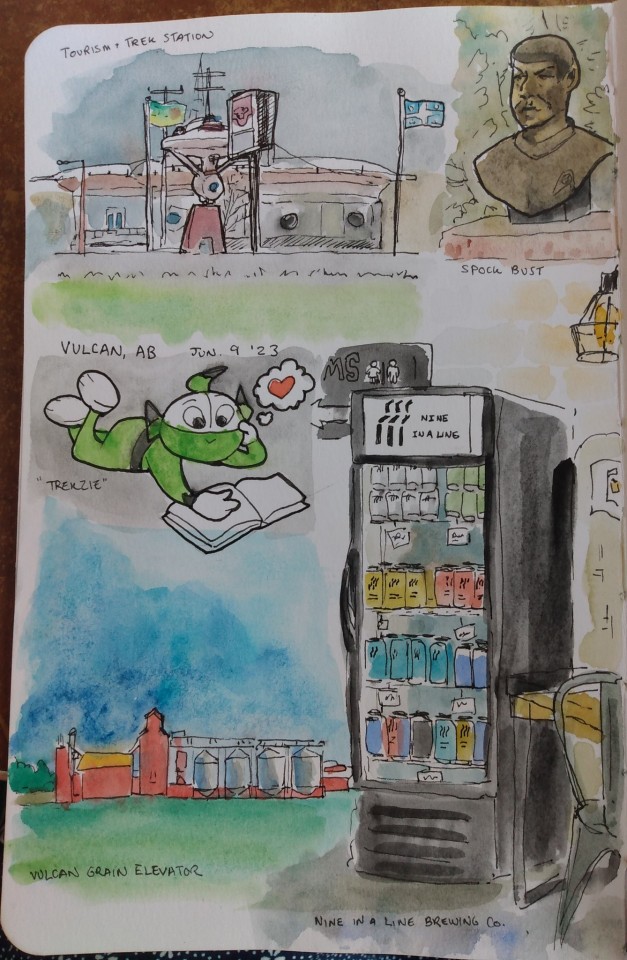
Day 2-3: Vulcan
Featuring the Enterprise and Tourism and Trek Station, the bust of Spock, Trekzie the alien, Nine in a Line Brewing Co., and the Vulcan grain elevator.
#hapo art#traditional art#urban sketching#rural sketching#ink#watercolour#mixed media#vulcan#alberta#canada
16 notes
·
View notes
Text
Southern Lagoon lies on Belize’s central coast and sustains a large breeding population of manatees, fish, birds and other wildlife that supports the local community and attracts tourists.
The limestone hills adjacent to it have also drawn the attention of Vulcan Materials, an Alabama-based company that wants to mine the hills for limestone to ship to the U.S., after its mine in Quintana Roo was shuttered by the Mexican Government for environmental degradation.
Community resistance to the planned mine and its likely negative effects on the area’s natural beauty and tourism economy has been increasing: the nation’s Prime Minister and three members of the House of Representatives also oppose it, yet the company continues to pursue it.
34 notes
·
View notes
Text
Construction Aggregates Market Size, Share, Demand, Growth & Trends by 2031
Digital transformation in the construction sector is streamlining industrial operations and paving way for technological advancements. This factor is allowing contractors to improve output, which in turn is resulting in high demand for construction aggregates. As per a recent market survey by ESOMAR-certified consulting firm Future Market Insights (FMI), the global construction aggregates market reached US$ 344.4 Bn in 2021. Increasing investment in the infrastructure sector is anticipated to propel growth in the market, enabling expansion at 6.8% CAGR through 2031.
Rapid urbanization in countries such as China and India is encouraging expansion of construction of residential sectors and healthcare facilities, thereby boosting sales of construction aggregates. Besides this, government-backed initiatives for facilitating housing developments in the U.S. and the U.K. will positively shape the demand outlook for construction aggregates.
In addition to residential projects, expansions in the tourism and hospitality sector are creating lucrative growth opportunities for players operating in the market. Construction of hotels and resorts in counties like Germany and Italy is enhancing sales prospects of construction aggregates in the market.
Moreover, demand for sustainable and recyclable construction aggregates is creating avenues for innovation in the market. Leading players are capitalizing on this trend by sustainable alternatives in the market, augmenting the overall market growth.
Request a sample @ https://www.futuremarketinsights.com/reports/sample/rep-gb-2551
“Increasing government expenditure on infrastructural development, coupled with the adoption of latest technologies is shaping the growth outlook of construction aggregates market,” says the FMI analyst.
Key Takeaways from the Construction Aggregates Market Analysis
Based on product type, crushed stone will dominate the market due to its easy availability and affordable price.
Construction aggregates will find applications in the infrastructure sector owing to increasing spending towards expansion of roadways and railways projects.
The U.S. is anticipated to exhibit high growth during the forecast period. Sales in the U.S. is expected total US$ 16.4 Bn in 2021.
Expansions in the tourism and hospitality sector in Germany will create opportunities for construction aggregates sales.
China will emerge as the most lucrative market due to increasing industrialization and urbanization in the country.
Increasing investments in residential and infrastructural development in India will promote sales of construction aggregates in the country.
Japan and South Korea will collectively account for 7.2% of the total market share.
Competitive Landscape
Heidelberg Cement AG, Martin Marietta Materials Inc, LSR Group, LafargeHolcim Ltd., Cemex SAB de CV ADR, Vulcan Materials Company, CRH plc, Adelaide Brighton Ltd., Eurocement Group, and ROGERS GROUP INC. are among the leading players operating in the construction aggregates market.
As a part of their growth strategies, prominent players are emphasizing on production facility expansion and new product launches. Apart from these strategies, strategic collaborations, mergers and acquisitions will hold significance during the forecast period. For instance:
In July 2021, Germany-based HeidelbergCement announced its plans to invest in additional grinding capacity for its cement plants. These additions will potentially help the company cater to growing consumers’ demand.
In May 2021, Martin Marietta Materials Inc. acquired HeidelberCement’s Lehigh Hanson West Region business for US$ 2.3 Bn. The transaction includes the sale of cement, aggregates, ready-mix concrete, and asphalt in the U.S. West region, allowing the company to expand its footprint across the country.
Construction Aggregates Market by Category
By Product Type:
Crushed Stone
Sand
Gravels
By Application Type:
Commercial
Residential
Industrial
Infrastructure
By Region:
North & Central America
South America
India
China
Australia & New Zealand
Middle East
Africa
Rest of APAC
Southern & Western Europe
CIS & Eastern Europe
Northern Europe
Browse Full Reports: https://www.futuremarketinsights.com/reports/construction-aggregates-market
0 notes
Text
The anti-slip cloth features Anti-slip cloth uses
Non-slip cloth characteristics, non-slip cloth uses, the non-slip cloth is also known as dense cloth or password cloth, the product is soft and waterproof, flame retardant and sound insulation, toughness and tear resistance, strong anti-slip effect, mildew-proof and moisture-proof, anti-wrinkle and slip. The PVC foam contains a tear-proof fiber layer, and the double-layer foam + mesh fiber greatly increases the tensile strength. The colors are colorful, elegant and beautiful, soft and comfortable, and light and durable. Good elasticity, good anti-slip effect, easy to cut, easy to replace, easy to clean. Water absorption and dust absorption, strong adsorption, mildew, and shockproof, sound insulation, and heat insulation. No dust, non-toxic, odorless, and environmentally friendly. The product is made of natural environmental protection material PVC+polyester mesh cloth and foamed at high temperature, which is non-adhesive and non-slip cloth. It is non-toxic, tasteless, antibacterial, and environmentally friendly. The product has passed the SGS Hong Kong general fair test and meets the American ASTMD3421-75 and EN-71 (EU toy safety monitoring) and other testing standards.
Anti-slip cloth is a kind of strong anti-slip, high elasticity, waterproof, non-oil, and easy to clean. It can overcome other carpets that are easy to slide, deformed after repeated trampling, moldy, moth, and other phenomena. It can be used as household products, daily necessities, sports tourism products, fitness products, and sports and leisure products. The special liquid silicone for non-slip cloth is a two-component heating vulcanized silicone rubber. After inspection, it can be cured at room temperature or heated. It has colorless or skin-colored oily liquid. After vulcanization, it becomes a soft elastic material, which can be used to make insoles and shoulder pads. , SMD, anti-skid pads, car seat cushions, and other flexible silicone rubber products. Unchanging shape, changeable appearance, soft touch, high tear resistance.
Anti-slip cloth is a kind of mat made of silicone to prevent objects from sliding. According to its application function, it can be divided into mobile phone drop plastic cloth, car PVC anti-slip cloth, bathhouse PVC anti-slip cloth, yoga PVC anti-slip cloth, and cup PVC anti-slip cloth. However, there are usually PVC dripping cloth, PU dripping cloth, and silicone dripping cloth in the market. The advantages and disadvantages of different raw materials and the quotations are also different. Their functions are basically the same, but the most outstanding functions of silicone pads are high and low-temperature resistance, soft material, and electrical insulation. are widely liked. The product design is unique, healthy and environmentally friendly, elegant and beautiful, but the price is slightly higher.
About CHENSHIJI:
Changshu Chen shi Ji Nonwoven Products Co., Ltd. is a manufacturer that specialized in needle-punched or laminated nonwoven fabrics. with roll making, and hot shrinking, we produce various products to different customers' standards, which integrates design, development, manufacture, and sales.
Our products are wildly used in wrapping, moving blankets, and Floor Protection. painter fleece is our hot-selling product. when decorating the house it is covered on the floor to effectively protect the floor from dirt and breaking down. with the function of waterproof, anti-slip, and eco-friendly. Painter fleece is very popular in Europe, the Middle East, America, and Australia.
0 notes
Photo

The Slumbering Sehlat lodge by Lake Yuron in the Shi’Kahr province, Vulcan.
Source: Hidden Universe Travel Guides: Star Trek: Vulcan. Art by Livio Ramondelli and Peter Markowski.
58 notes
·
View notes
Note
I may or not have had the best T’pol and trip idea since that comic you did abt Trip calling T’pol a snazzy dresser and T’pol saying he has clothes (which literally killed me). Imagine T’pol taking Trip shopping to improve his style, and him trying to get her to buy some Hawaiian shirts. If your still taking requests I would love to see it! If not totally understand! :)

THATS SO CUTE... she convinces him to get some vulcan robes and he somehow manages to get her a hawaiian shirt
#hangin out like on risa? that seems like the most likely place to have both vulcan robes and hawaiian shirts For The Tourism (tm)#anyways thank u im having lots of fun rjslkdjfsjvskldjf\#trip tucker#t'pol#ent#star trek enterprise#tnt#orig#cadet responds
342 notes
·
View notes
Text
Kov-kitaya. Stone carvings.

9 notes
·
View notes
Photo

Acatenango - Guatemala (by Ramon -)
#Acatenango#Guatemala#Central America#America#Nature#Landscape#Outdoor#Vulcan#Photogrpahy#Travelling#Traveling#Travel#Tourism#Holiday#Urlaub#Reisen
637 notes
·
View notes
Photo
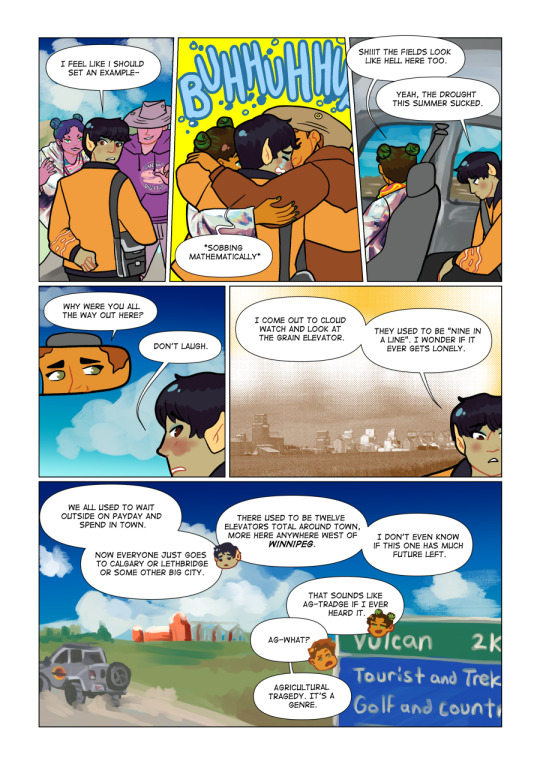
Battle of Alberta Chapter 6: Cloud Minding pg. 3
Another story about the personified cities (and towns) of the wild rose province in a land known to some as Canada. Cloud Minding shifts the focus from the big cities to the more rural areas, where lives and livelihoods are drifting away from traditional industries towards tourism. Updates every other Friday, fingers crossed.
<< [ First ] < [ Previous ] - [ Next ] >
It’s been another rough year.
Grain elevators are so iconic. I get torn between the frustration that the rest of Canada seems to think we’re only grain elevators and the frustration that people don’t seem to know how important and interesting they have been historically here! There are very few of them left and operating. There are a couple great examples here in the Edmonton area, such as one at the Ukrainian Village north of the city, the Spruce Grove Grain Elevator Museum to the west, and one inside the Reynold’s Museum in Wetaskiwin to the south. I’m sure there are numerous other examples across the prairies of these “Prairie Sentinels” or “Prairie Giants”.
The Vulcan Pioneer elevator is one of two still standing around the town, there’s a brewery in the area called “Nine in a Line” in honour of the former elevators.
easter eggs
- ag-tradge (agricultural tragedy) is the self-proclaimed genre of music played by Corb Lund (a southern AB icon who is currently fighting the province over strip mining in the rockies)
things I don’t miss
do you want to buy something and you live in a small town? your only choice is the nearest city with a wal mart or a canadian tire :) now amazon also exists but that’s also a problem, obviously.
#projectcanada cities#aph oc#hws oc#hetalia oc#pc: vulcan#pc: drumheller#pc: st. paul#digital art#clip studio paint#hapo art#boab comic#boab cloud minding
15 notes
·
View notes
Text
Subatomic Tourism: As Hot As Vulcan.
As Hot As Vulcan.
View On WordPress
0 notes
Text
Mt.isarog is one of the most unique places in the country although it is vulcan it has hidden treasures not even in gold but in beautiful places here in the country, it is one of the places visited by tourists not only in the country but also other races want to see the beauty inside the place it is located in all places here in camarines sur I took part in a hike so I could experience the full mental health endorphin boosting effect especially when outdoors. I thoroughly immersed myself in the natural stress relieving benefits of fresh air and Mother Nature. I have found that simple activities like walking my dogs have proven to be a great opportunity each day to naturally practice mindfulness. The positive effects of the workout were magnified tenfold when I was there in the wilderness hiking for the Mind, traveling and exploring my way to new paths and seeing sights I had never seen before.
when I was there I'd stop and pause, taking silent pictures with my mind as well as my camera, hoping I would always feel the way I felt when I was out there.
Local Tourism BY: Maricris San Luis


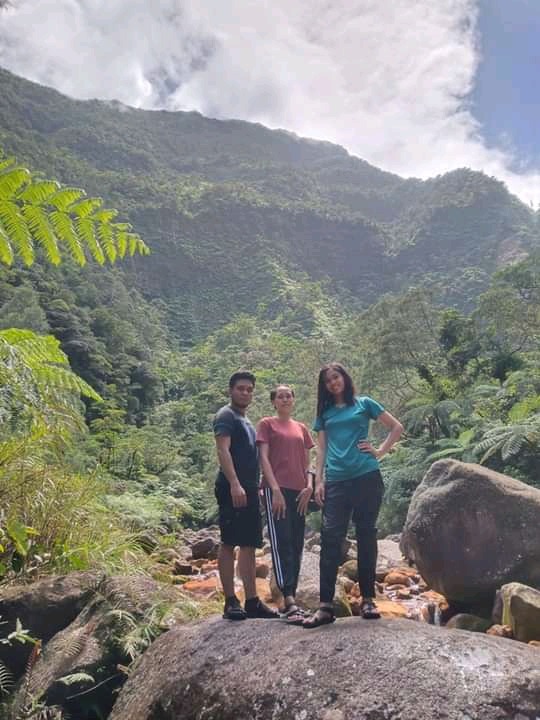
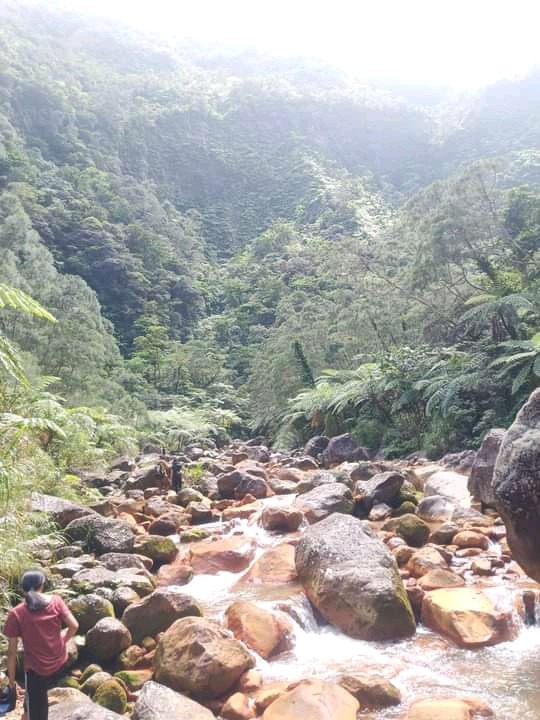

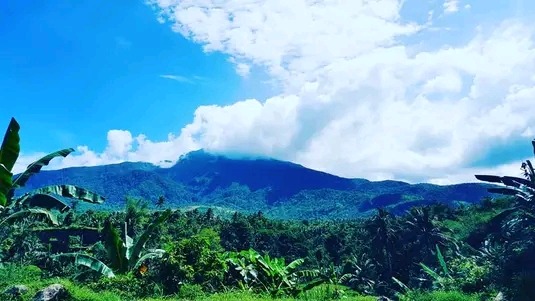
#TMPE6 Travel Writing and Photography
2 notes
·
View notes
Photo
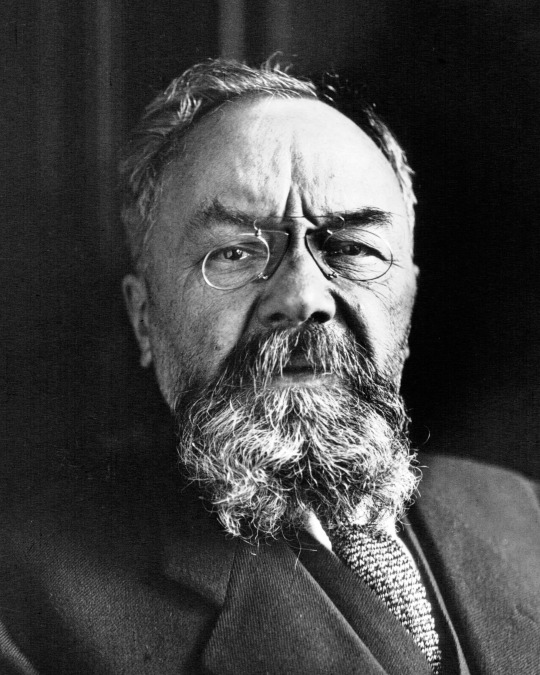
André Jules Michelin was born on 16 January 1853. He was a French industrialist who, with his brother Édouard (1859–1940), founded the Michelin Tyre Company (Compagnie Générale des Établissements Michelin) in 1888 in the French city of Clermont-Ferrand.
In 1900, André Michelin published the first Michelin Guide, the purpose of which was to promote tourism by car, thereby supporting his tyre manufacturing operation.
In 1886, 33-year-old André Michelin abandoned his career as a successful Parisian engineer to take over his grandfather's failing agricultural goods and farm equipment business. Established in 1832,"Michelin et Cie" suffered from neglect and was on the verge of insolvency following the founder's death. Michelin's grandfather had started the company that sold farm equipment and an odd assortment of vulcanized rubber products, such as belts, valves and pipes. As soon as André took the helm of the company, he recruited his younger brother Édouard to join him at the company. Édouard was named the company's managing director. While duly committed to the success of the business, neither brother had any prior experience selling goods or had the slightest idea where to even begin.
In 1889, a cyclist familiar with the Michelin Company approached Édouard with his flat tyre seeking assistance. Getting a flat tyre frequently meant cyclists were left stranded for hours. In the late 1880s, cycling was becoming a popular form of transportation and hobby due in large part to John Dunlop's 1888 patent for the inflatable bicycle tyre. Before Dunlop's invention, bicycle tyres were made out of solid rubber. The solid rubber tyres tended to provide little traction and made for a difficult and uncomfortable ride.
After the hapless cyclist approached the Michelin Company for assistance, Édouard took great interests in the new pneumatic tyres. The Michelins recognized that there would be a great demand for pneumatic tyres if only there was a way to more quickly make repairs. They reasoned that first the wheel must become detachable. Édouard conducted a series of experiments and developed a number of prototypes. In 1891, he was granted a patent for a detachable tire.
André and his brother Édouard were inducted into the Automotive Hall of Fame in Dearborn, Michigan in 2002.
Daily inspiration. Discover more photos at http://justforbooks.tumblr.com
8 notes
·
View notes
Photo

“what language should I learn?”
“is it better to learn [x] or [x]?”
“is it worth learning [x]?”
I get this type of question a lot and I see questions like these a lot on language learning forums, but it’s very difficult to answer because ultimately language learning is a highly personal decision. Passion is required to motivate your studies, and if you aren’t in love with your language it will be very hard to put in the time you need. Thus, no language is objectively better or worse, it all comes down to factors in your life. So, I’ve put together a guide to assist your with the kind of factors you can consider when choosing a language for study.
First, address you language-learning priorities.
Think of the reasons why are you interested in learning a new language. Try to really articulate what draws you to languages. Keeping these reasons in mind as you begin study will help keep you focused and motivated. Here are some suggestions to help you get started, complete with wikipedia links so you can learn more:
Linguistic curiosity?
For this, I recommend looking into dead, literary or constructed languages. There are lots of cool linguistic experiments and reconstructions going on and active communities that work on them! Here’s a brief list:
Dead languages:
Akkadian
Egyptian (Ancient Egyptian)
Gaulish
Gothic
Hittite
Old Prussian
Sumerian
Older iterations of modern day languages:
Classical Armenian
Classical Nahuatl (language of the Aztec Empire)
Early Modern English (Shakespearean English)
Galician-Portuguese
Middle English (Chaucer English)
Middle Persian/Pahlavi
Old English
Old French
Old Spanish
Old Tagalog (+ Baybayin)
Ottoman Turkish
Constructed:
Anglish (experiment to create a purely Anglo-Saxon English)
Esperanto
Interlingua
Láadan (a “feminist language”)
Lingua Franca Nova
Lingwa de Planeta
Lobjan
Toki Pona (a minimalist language)
Wenedyk (what if the Romans had occupied Poland?)
Cultural interests?
Maybe you just want to connect to another culture. A language is often the portal to a culture and are great for broadening your horizons! The world is full of rich cultures; learning the language helps you navigate a culture and appreciate it more fully.
Here are some popular languages and what they are “famous for”:
Cantonese: film
French: culinary arts, film, literature, music, philosophy, tv programs, a prestige language for a long time so lots of historical media, spoken in many countries (especially in Africa)
German: film, literature, philosophy, tv programs, spoken in several Central European countries
Italian: architecture, art history, catholicism (Vatican city!), culinary arts, design, fashion, film, music, opera
Mandarin: culinary arts, literature, music, poetry, tv programs
Japanese: anime, culinary arts, film, manga, music, video games, the longtime isolation of the country has developed a culture that many find interesting, a comparatively large internet presence
Korean: tv dramas, music, film
Portuguese: film, internet culture, music, poetry
Russian: literature, philosophy, spoken in the Eastern Bloc or former-Soviet countries, internet culture
Spanish: film, literature, music, spoken in many countries in the Americas
Swedish: music, tv, film, sometimes thought of as a “buy one, get two free” deal along with Norwegian & Danish
Religious & liturgical languages:
Avestan (Zoroastrianism)
Biblical Hebrew (language of the Tanakh, Old Testament)
Church Slavonic (Eastern Orthodox churches)
Classical Arabic (Islam)
Coptic (Coptic Orthodox Church)
Ecclesiastical Latin (Catholic Church)
Ge’ez (Ethiopian Orthodox Church)
Iyaric (Rastafari movement)
Koine Greek (language of the New Testament)
Mishnaic Hebrew (language of the Talmud)
Pali (language of some Hindu texts and Theravada Buddhism)
Sanskrit (Hinduism)
Syriac (Syriac Orthodox Church, Maronite Church, Church of the East)
Reconnecting with family?
If your immediate family speaks a language that you don’t or if you are a heritage speaker that has been disconnected, then the choice is obvious! If not, you might have to do some family tree digging, and maybe you might find something that makes you feel more connected to your family. Maybe you come from an immigrant community that has an associated immigration or contact language! Or maybe there is a branch of the family that speaks/spoke another language entirely.
Immigrant & Diaspora languages:
Arbëresh (Albanians in Italy)
Arvanitika (Albanians in Greece)
Brazilian German
Canadian Gaelic (Scottish Gaelic in Canada)
Canadian Ukrainian (Ukrainians in Canada)
Caribbean Hindustani (Indian communities in the Caribbean)
Chipilo Venetian (Venetians in Mexico)
Griko (Greeks in Italy)
Hutterite German (German spoken by Hutterite settlers of Canada/US)
Fiji Hindi (Indians in Fiji)
Louisiana French (Cajuns)
Patagonian Welsh (Welsh in Argentina)
Pennsylvania Dutch (High German spoken by early settlers of Canada/ the US)
Plaudietsch (German spoken by Mennonites)
Talian (Venetian in Brazilian)
Texas Silesian (Poles in the US)
Click here for a list of languages of the African diaspora (there are too many for this post!).
If you are Jewish, maybe look into the language of your particular diaspora community ( * indicates the language is extinct or moribund - no native speakers or only elderly speakers):
Bukhori (Bukharan Jews)
Hebrew
Italkian (Italian Jews) *
Judeo-Arabic (MENA Jews)
Judeo-Aramaic
Judeo-Malayalam *
Judeo-Marathi
Judeo-Persian
Juhuri (Jews of the Caucasus)
Karaim (Crimean Karaites) *
Kivruli (Georgian Jews)
Krymchak (Krymchaks) *
Ladino (Sephardi)
Lusitanic (Portuguese Jews) *
Shuadit (French Jewish Occitan) *
Yevanic (Romaniotes)*
Yiddish (Ashkenazi)
Finding a job?
Try looking around for what languages are in demand in your field. Most often, competency in a relevant makes you very competitive for positions. English is in demand pretty much anywhere. Here are some other suggestions based on industry (from what I know!):
Business (General): Arabic, French, German, Hindi, Korean, Mandarin, Russian, Spanish
Design: Italian (especially furniture)
Economics: Arabic, German
Education: French, Spanish
Energy: Arabic, French, German, Portuguese, Russian, Spanish
Engineering: German, Russian
Finance & Investment: French, Cantonese, German, Japanese, Mandarin, Russian, Spanish
International Orgs. & Diplomacy (NATO, UN, etc.): Arabic, French, Mandarin, Persian, Russian, Spanish
Medicine: German, Latin, Sign Languages, Spanish
Military: Arabic, Dari, French, Indonesian, Korean, Kurdish, Mandarin, Pashto, Persian, Russian, Spanish, Turkish, Urdu
Programming: German, Japanese
Sales & Marketing: French, German, Japanese, Portuguese
Service (General): French, Mandarin, Portuguese, Russian, Sign Languages, Spanish
Scientific Research (General): German, Japanese, Russian
Tourism: French, Japanese, Mandarin, Sign Languages, Spanish
Translation: Arabic, Russian, Sign Languages
Other special interests?
Learning a language just because is a perfectly valid reason as well! Maybe you are really into a piece of media that has it’s own conlang!
Fictional:
Atlantean (Atlantis: The Lost Empire)
Dothraki (Game of Thrones)
Elvish (Lord of the Rings)
Gallifreyan (Doctor Who)
High Valyrian (Game of Thrones)
Klingon (Star Trek)
Nadsat (A Clockwork Orange)
Na’vi (Avatar)
Newspeak (1984)
Trigedasleng (The 100)
Vulcan (Star Trek)
Or if you just like to learn languages, take a look maybe at languages that have lots of speakers but not usually popular among the language-learning community:
Arabic
Bengali
Cantonese
Hindi
Javanese
Hausa
Indonesian
Malay
Pashto
Persian
Polish
Punjabi
Swahili
Tamil
Telugu
Thai
Turkish
Urdu
Vietnamese
Yoruba
If you have still are having trouble, consider the following:
What languages do you already speak?
How many and which languages you already speak will have a huge impact on the ease of learning.
If you are shy about speaking with natives, you might want to look at languages with similar consonant/vowel sounds. Similarity between languages’ grammars and vocabularies can also help speed up the process. Several families are famous for this such as the Romance languages (Spanish, Portuguese, Italian, French, Romanian), North Germanic languages (Norwegian, Swedish, Danish) or East Slavic languages (Russian, Ukrainian, Belarusian). If you are a native English speaker, check out the FSI’s ranking of language difficulty for the approximate amount of hours you’ll need to put into different languages.
You could also take a look at languages’ writing systems to make things easier or for an added challenge.
Another thing to remember is that the languages you already speak will have a huge impact on what resources are available to you. This is especially true with minority languages, as resources are more frequently published in the dominant language of that area. For example, most Ainu resources are in Japanese, most Nheengatu resources are in Portuguese, and most Nahuatl resources are in Spanish.
What are your life circumstances?
Where you live with influence you language studies too! Local universities will often offer resources (or you could even enroll in classes) for specific languages, usually the “big” ones and a few region-specific languages.
Also consider if what communities area near you. Is there a vibrant Deaf community near you that offers classes? Is there a Vietnamese neighborhood you regularly interact with? Sometimes all it takes is someone to understand you in your own language to make your day! Consider what languages you could realistically use in your own day-to-day. If you don’t know where to start, try checking to see if there are any language/cultural meetups in your town!
How much time can you realistically put into your studies? Do you have a fluency goal you want to meet? If you are pressed for time, consider picking up a language similar to ones you already know or maintaining your other languages rather than taking on a new one.
Please remember when choosing a language for study to always respect the feelings and opinions of native speakers/communities, particularly with endangered or minoritized languages. Language is often closely tied to identity, and some communities are “closed” to outsiders. A notable examples are Hopi, several Romani languages, many Aboriginal Australian languages and some Jewish languages. If you are considering a minoritized language, please closely examine your motivations for doing so, as well as do a little research into what is the community consensus on outsiders learning the language.
#o#writing this post took a long time but it was really fun!!#langblr#language learning#choosing a language
2K notes
·
View notes